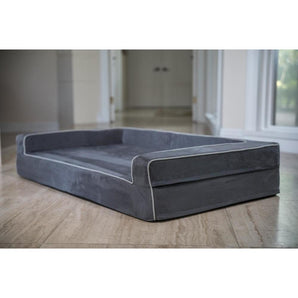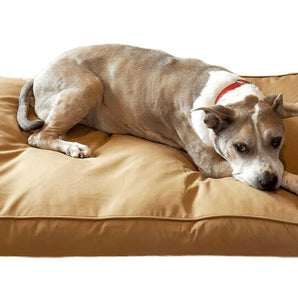Dogs pant for many reasons, and while it can be a normal response to heat or exercise, excessive panting can sometimes indicate stress or discomfort. Knowing why your dog is panting and how to calm them can help keep your furry friend happy and healthy.
We'll share some practical methods to soothe your anxious dog, including:
-
Provide a Cool and Comfortable Environment
-
Offer Fresh Water and Hydration
-
Use Relaxation Techniques
-
Create a Quiet and Calm Atmosphere
-
Encourage Slow and Deep Breathing
-
Use Distraction Methods with Toys or Treats
-
Avoid Stressful Situations or Triggers
-
Consider Anxiety-Reducing Supplements or Products
Why Do Dogs Pant?

Panting is a normal behavior in dogs, primarily used to regulate body temperature. Since dogs don’t sweat like humans, panting allows them to cool down by evaporating moisture from their tongue and respiratory tract.
However, panting can also be a response to stress, anxiety, or excitement. Situations like car rides, visits to the vet, loud noises, or unfamiliar environments can cause anxious dogs to pant more than usual. Additionally, pain or underlying health issues can lead to excessive panting, making it important to understand the context in which your dog is panting.
Do Some Dog Breeds Pant More Than Others?
Some dog breeds do pant more than others due to their physical characteristics and activity levels. Brachycephalic breeds like Bulldogs, Pugs, and Shih Tzus, with their short noses and flat faces, are more prone to panting because they have narrower airways, making it harder for them to cool down. High-energy breeds such as Border Collies and Australian Shepherds also tend to pant more due to their high activity levels and increased need for oxygen.
How to Calm a Panting Dog

1. Provide a Cool and Comfortable Environment
One of the simplest ways to calm a panting dog is by ensuring they have a cool and comfortable environment. Overheating is a common cause of panting, so it’s important to keep your dog cool in a well-ventilated, shaded area, especially during hot weather. Air conditioning or fans can help lower the temperature, making it easier for your dog to cool down.
2. Offer Fresh Water and Hydration
Hydration is key in preventing and calming a dog who is panting excessively. Always have fresh water available for your dog, especially during and after physical activity or when the weather is warm. You can also offer ice cubes or frozen treats as a fun and effective way to help cool your dog down in the warm summer months. Ensuring your dog stays well-hydrated will help regulate their body temperature and alleviate panting caused by heat or dehydration.
Pet parents should observe their dog’s behavior closely for signs of dehydration, such as dry gums or lethargy, as many dogs may pant excessively when dehydrated. Regularly refreshing your dog’s water bowl and ensuring they drink enough, especially during hot weather or after exercise, is essential. Additionally, using a pet water fountain can encourage more frequent drinking, helping to keep your dog properly hydrated and reducing instances of excessive panting.
3. Use Relaxation Techniques
Especially for a particularly anxious dog, relaxation techniques can be very effective in calming a panting pooch. Gentle petting, massaging your dog’s ears or body, and speaking to them in a calm, soothing voice can help reduce anxiety and stress. Some dogs respond well to gentle pressure, such as a calming wrap or vest that applies a constant, reassuring pressure to their body. These techniques can help your dog feel secure and reduce panting related to anxiety or excitement.
4. Create a Quiet and Calm Atmosphere
Loud noises, bustling environments, and unfamiliar faces can all contribute to your dog’s stress levels. Designate a quiet space in your home where your dog can retreat to when they need a break. This area should be free from distractions and filled with comforting items like their favorite toys, blankets, and a comfortable and supportive dog bed. A quiet environment will help your dog feel safe and secure, reducing anxiety-induced panting.
Many dogs benefit from having a consistent and tranquil area they can rely on during stressful times. For dogs with severe anxiety, adding calming music or white noise to their environment can further drown out external stressors.
5. Encourage Slow and Deep Breathing
Encouraging your dog to breathe slowly and deeply can help calm them down. While you can’t directly instruct your dog on how to take a deep breath, you can influence their breathing patterns through your actions. When you notice your dog panting heavily, try to model calm behavior yourself. Sit quietly with your dog, breathe slowly and deeply, and encourage them to lie down and relax. Over time, your calm demeanor can help your dog mirror your behavior and start to calm down themselves.
6. Use Distraction Methods with Toys or Treats
Distraction can be a powerful tool to calm a panting dog. Engaging your dog in a favorite activity or offering them a treat can redirect their focus away from whatever is causing their anxiety. Interactive toys, puzzle feeders, or a tasty treat can capture your dog's attention and provide mental stimulation. These distractions not only help to calm your dog but also provide positive reinforcement, associating calm behavior with enjoyable experiences.
7. Avoid Stressful Situations or Triggers
If you're struggling with how to calm a panting dog, removing them from stressful situations will almost always help. If certain situations or environments consistently cause your dog to pant, try to minimize their exposure to these triggers. For example, if your dog becomes anxious during car rides, gradually acclimate them by taking short, positive trips and slowly increasing the duration as they become more comfortable. Understanding and avoiding your dog’s stress triggers will help maintain their overall well-being and reduce anxiety-induced panting.
Changes in the household, such as new family members or pets, can also affect your dog’s behavior and anxiety levels. Implementing gradual introductions and providing a safe, quiet space can help mitigate these stressors. Additionally, monitoring your dog’s behavior closely and adjusting routines as needed can prevent situations that might cause severe anxiety and excessive dog panting.
8. Consider Anxiety-Reducing Supplements or Products
In some cases, anxiety-reducing supplements or products can be helpful in calming a panting dog. Products like calming chews, pheromone diffusers, or natural supplements designed to reduce anxiety can provide additional support.
Look for calming chews with the following ingredients:
-
Chamomile: Natural relaxant that helps reduce anxiety and promotes calmness.
-
Valerian Root: Acts as a sedative to soothe nervousness and anxiety, helping dogs relax.
-
L-Tryptophan: An amino acid that helps produce serotonin, which improves mood and promotes relaxation.
-
Melatonin: A hormone that regulates sleep, aiding in reducing anxiety and promoting restful sleep.
-
Passionflower: Contains natural compounds that help alleviate anxiety and stress.
-
Ginger Root: Helps with digestive comfort and can ease nausea that sometimes accompanies anxiety.
-
L-Theanine: An amino acid found in tea that promotes relaxation without drowsiness.
-
Magnesium: A mineral that helps regulate the nervous system and reduce stress.
-
Thiamine (Vitamin B1): Supports the nervous system and can help reduce stress and anxiety.
-
Hemp Oil/CBD: Contains cannabinoids that have calming effects and can reduce anxiety and stress.
Always consult your veterinarian before introducing any new supplement to ensure it’s safe and appropriate for your dog.
When to Seek Professional Help For Excessive Panting

While occasional dog panting is normal in a healthy dog, excessive or persistent panting can indicate a more serious issue. If your dog’s panting is accompanied by symptoms such as lethargy, coughing, difficulty breathing, or changes in behavior, you should contact your vet immediately. These signs can indicate underlying health problems that require medical attention. Regular check-ups and open communication with your veterinary medicine doctor are essential in maintaining your dog’s health and addressing any concerns promptly.
Help Calm Your Anxious Dog and Reduce Panting
When you know how to calm a panting dog, you can significantly improve their quality of life and help them feel more secure. Understanding the reasons behind panting and implementing effective strategies can make a world of difference for both you and your furry friend. By providing a cool and comfortable environment, ensuring proper hydration, using relaxation techniques, and creating a calm atmosphere, you can address the common causes of excessive panting.





